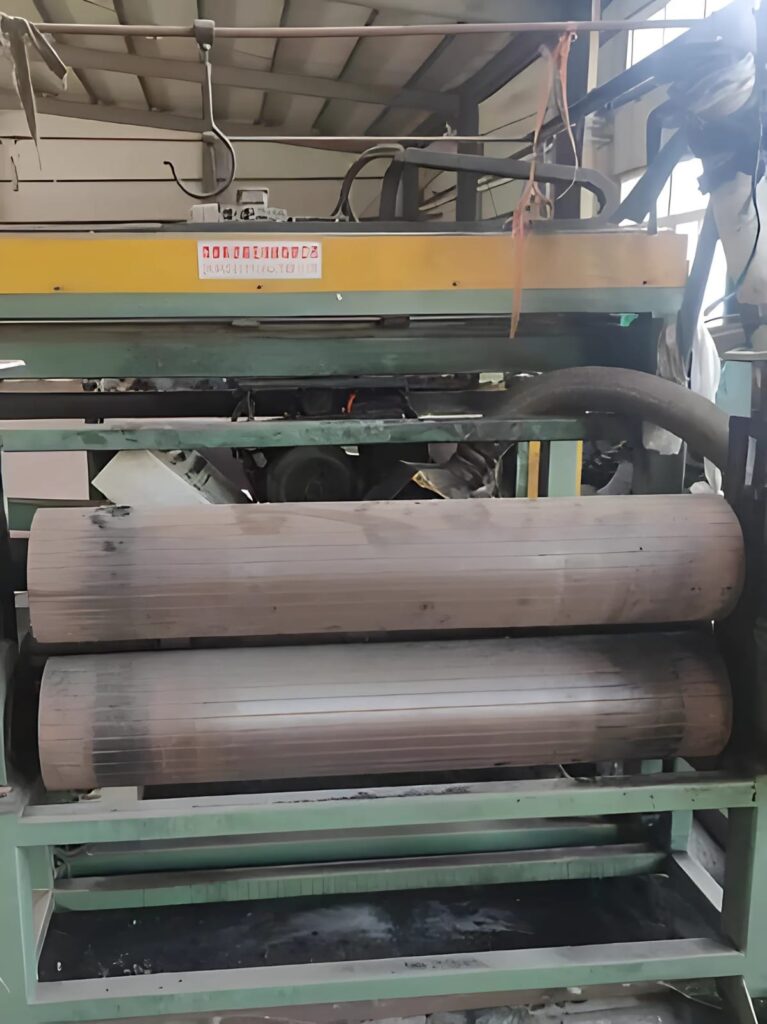Rubber belt production line
Buy | Sell Pre-Owned Rubber Conveyor Belt Building Table 1800 mm
| Parameter | unit | VAT-1800X12000*2 | VAT-1800X10000*2 | VAT-1600X10000*2 | VAT-1600X10000*1 | VAT-1400X10000*1 |
| Hot-plate size | mm | 1800*12000 | 1800*1000 | 1600*10000 | 1600*10000 | 1400*10000 |
| Total pressure | mn | 74 | 72 | 56 | 64 | 49 |
| Hot-plate unit pressure | mpa | 3.4 | 4 | 3.5 | 4 | 3.5 |
| Plunger diameter | mm | 500 | 500 | 450 | 500 | 450 |
| Plunger No | 18 | 18 | 18 | 18 | 18 | |
| Max plunger stroke | mm | 400 | 300 | 400 | 300 | 300 |
| Gripping strength | mn | 1.2 | 1.5 | 1.2 | 1.2 | 0.9 |
| Tension force | mn | 1.101.2 | 1.1 | 1 | 0.5 | 0.9 |
| Steam pressure | mpa | 0.63 | 0.6-0.8 | 0.63 | 0.6-0.8 | 0.63 |
| Cooling water pressure | mpa | 0.3 | 0.3 | 0.3 | 0.3 | 0.3 |
| controlling method | PLC | PLC | PLC | PLC | PLC |
Buy | Sell Used 1400 X 5700 mm Rubber Conveyor Belt Vulcanizing Press Curing Line
| Parameter | unit | VAT-1800X | VAT-1800X | VAT-1600X | VAT-1600X | VAT-1400X |
| 12000*2 | 10000*2 | 10000*2 | 10000*1 | 10000*1 | ||
| Hot-plate size | mm | 1800*12000 | 1800*1000 | 1600*10000 | 1600*10000 | 1400*10000 |
| Total pressure | mn | 74 | 72 | 56 | 64 | 49 |
| Hot-plate unit pressure | mpa | 3.4 | 4 | 3.5 | 4 | 3.5 |
| Plunger diameter | mm | 500 | 500 | 450 | 500 | 450 |
| Plunger No | 18 | 18 | 18 | 18 | 18 | |
| Max plunger stroke | mm | 400 | 300 | 400 | 300 | 300 |
| Gripping strength | mn | 1.2 | 1.5 | 1.2 | 1.2 | 0.9 |
| Tension force | mn | 1.101.2 | 1.1 | 1 | 0.5 | 0.9 |
| Steam pressure | mpa | 0.63 | 0.6-0.8 | 0.63 | 0.6-0.8 | 0.63 |
| Cooling water pressure | mpa | 0.3 | 0.3 | 0.3 | 0.3 | 0.3 |
| controlling method | PLC | PLC | PLC | PLC | PLC |
Buy | Sell Used Rubber Conveyor Belt Production Line 1200 X1800
| Parameter | unit | VAT-1800X12000*2 | VAT-1800X10000*2 | VAT-1600X10000*2 | VAT-1600X10000*1 | VAT-1400X10000*1 |
| Hot-plate size | mm | 1800*12000 | 1800*1000 | 1600*10000 | 1600*10000 | 1400*10000 |
| Total pressure | mn | 74 | 72 | 56 | 64 | 49 |
| Hot-plate unit pressure | mpa | 3.4 | 4 | 3.5 | 4 | 3.5 |
| Plunger diameter | mm | 500 | 500 | 450 | 500 | 450 |
| Plunger No | 18 | 18 | 18 | 18 | 18 | |
| Max plunger stroke | mm | 400 | 300 | 400 | 300 | 300 |
| Gripping strength | mn | 1.2 | 1.5 | 1.2 | 1.2 | 0.9 |
| Tension force | mn | 1.101.2 | 1.1 | 1 | 0.5 | 0.9 |
| Steam pressure | mpa | 0.63 | 0.6-0.8 | 0.63 | 0.6-0.8 | 0.63 |
| Cooling water pressure | mpa | 0.3 | 0.3 | 0.3 | 0.3 | 0.3 |
| controlling method | PLC | PLC | PLC | PLC | PLC |
Buy | Sell Used Rubber Textile Fabric Conveyor Belt Production line 1600 X10000 mm
Textile fabric conveyor belt line for sale.
All machines are for textile fabric conveyor belts:
Two sets of 1.6m✘6m
one set of 1.6m✘6.5m
one set of 1.2✘10m.
The equipment is from Wuxi Jinhe, all is single-layer
A rubber conveyor belt production line involves various processes to create durable and efficient conveyor belts used in industries for material transportation. The production line typically includes several key stages:- Raw Material Preparation: The process begins with selecting high-quality raw materials such as natural rubber, synthetic rubber, and reinforcing materials like fabric or steel cords.
- Compounding: The selected raw materials are then mixed and compounded to create a homogeneous rubber compound. This process is crucial to achieving the desired properties such as strength, flexibility, and resistance.
- Calendering: The compounded rubber is passed through calenders to form sheets of the required thickness. Calendars help in shaping and smoothing the rubber.
- Fabrication: Layers of fabric or steel cords are added to provide reinforcement and enhance the strength of the conveyor belt. The number and arrangement of these layers depend on the desired characteristics of the final product.
- Vulcanization: The assembled conveyor belt goes through a vulcanization process, involving heat and pressure. This step cures the rubber, creating a robust and durable structure.
- Cutting and Finishing: Once vulcanized, the conveyor belt is cut to the desired width and length. Additional finishing processes may include applying coatings for specific functionalities, such as resistance to abrasion or chemicals.
- Quality Control: Throughout the production line, rigorous quality control measures are implemented to ensure that the conveyor belts meet industry standards and customer specifications.
- Flat Belt: Suitable for horizontal conveyance.
- Incline or Decline Belt: Designed for transporting materials at an angle.
- Cleated Belt: Features cleats or partitions for elevating materials.
- Sidewall Belt: Ideal for vertical conveying with attached side walls.
- Steel Cord Belt: Reinforced with steel cords for heavy-duty applications.
- Heat-Resistant Belt: Designed to withstand high temperatures.
- Oil-Resistant Belt: Resistant to oil and grease.

 Compression Molding
Compression Molding






